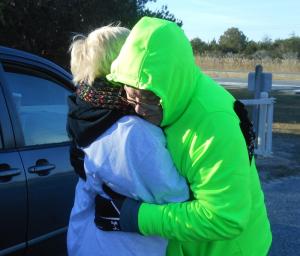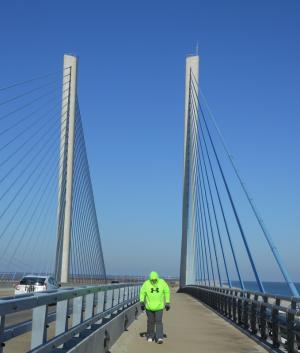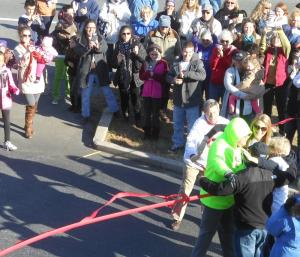Tim Hill: ALS' Miracle Man
In the moments immediately following the completion of a 10-mile walk from Dewey Beach to Bethany Beach, Tim Hill said he couldn't remember the last seven.
“I walked the first three, God walked the last seven,” Hill said to a crowd of supporters Nov. 22 who had gathered at the Wilgus Associates office in Bethany Beach to cheer on a man who was diagnosed with ALS eight months ago.
Hill, a Georgetown resident and Wilgus Associates vice president, made the journey solo as part of a fundraiser called the Ten-Mile Miracle for ALS. He was raising funds to help people suffering from ALS pay for items health insurance generally doesn't cover such as weighted forks and spoons, elastic shoelaces, canes, and computers that allow people to communicate by reading eye movement.
Hill said he and his wife have lived their lives, and raised their children, with the belief that when it's possible to help someone, you do.
“I just never thought it would also be for something that I was fighting,” he said. “This just gives me a new cause. It's the way I've raised my family.”
Hill said he got the idea after the ice bucket challenge that swept across that nation this past summer. He said that was a great fundraiser, but the money went straight to ALS clinics for patient care, and patients have other needs.
“I wanted to set up my own charity to raise funds for equipment so we can get the money to them directly,” he said. “There are no administrative costs. One hundred percent goes to patients.”
Hill, who hasn't missed a day of work since his diagnosis, said 10 miles was chosen because it's a distance that would take a miracle for him to finish.
Forty-eight hours prior to the walk, Hill was in good spirits and confident he was going to accomplish his goal.
“I don't have any doubt that I'm going to make it,” he said from behind his desk. “I probably won't be in the best shape, but I'll make it.”
Hill said he was hoping for a warm morning, because the cold temperatures cause his muscles to lock up.
“The cold is bad,” he put simply.
Living with ALS
According to the ALS Association website, Amyotrophic lateral sclerosis, often referred to as "Lou Gehrig's Disease," is a progressive neurodegenerative disease that affects nerve cells in the brain and the spinal cord. The progressive degeneration of the motor neurons in ALS eventually leads to death. Patients in the later stages of the disease may become totally paralyzed.
Hill said he didn't know much about the disease before being diagnosed. He said he knew there was a horrible ending, but other than that he had never known anyone with the disease.
The seemingly unrelated first signs of ALS began almost exactly three years ago, said Hill. There would be some shaking or bad cramping in the feet. He would lose his balance for no apparent reason, and he was always tired.
The final straw, said Hill, as a couple of bad spills he took while trying to walk stairs.
The day of his diagnostic test, the doctors were testing for Parkinson's disease (another neurological disease) or ALS.
“Before the test started, the doctor was telling me that I better hope I have Parkinson's,” said Hill. “It was pretty shocking. There's not a much worse diagnosis that you can hear.”
Immediately following the diagnoses, Hill and wife Cindy started walking and stretching for hours a day.
“My wife is a huge reason why I'm better,” he said. The couple have been married for 35 years and have two daughters, Elizabeth, 28, and Mary, 23. “She helps me with my medications. She reads up on the medical research. She's my biggest supporter.”
Hill said his wife took the news harder than he did, and telling his daughters has been the most challenging part.
“Telling the kids was a real issue,” he said.
At the time of his diagnosis, Hill could barely walk a block. Now, he regularly walks five miles with his wife. In addition to his wife's support, he credits the team at the Peninsula Regional Medical Center in Salisbury, Md.
They have been unbelievable, he said. They've been pushing me with therapy and a lot of coordination and balance work, he said.
Hill knows the disease will catch up eventually. Doctors don't have a cure, and its 100 percent fatal, he said, adding that the medical field says it's impossible to get better – only to stay the same for a period.
“I'm not looking forward to it. The ending isn't great,” he said. “I just don't think about it.”
But there's still never day he's not in pain because of the disease. The pain is bad enough that it feels like bones are going to break, he said. “But you just kind of learn to live with it,” he said.
The daily grind of the walking, stretching and therapy takes a toll.
“I have to keep this up, or I'll start to go backwards,” Hill said. “I don't know how long I'll continue to get better.”
He recently was able to walk his older daughter down the isle at her wedding in September.
“It was my daughter's day, and I didn't want to be the center of attention, but it was really tremendous,” he said.
Hill said he and his family haven't been dwelling on the diagnosis. He said instead they've chosen to focus on the positive times ahead.
“When I was diagnosed, the doctors said there was no hope for improvement,” he said. “But we caught it early enough, that if we stay ahead of it, and I continue through the physical therapy, I'm hoping to stay well for longer.”
The walk
The morning of the walk, Hill was dropped off at the oceanside entrance of Tower Road just south of Dewey Beach by his wife. The temperature was in the low 30s, but it was supposed to warm up to the low 50s, and there would be slight breeze at his back the whole time.
Hill was dressed in a winter cap, and wore multiple layers of clothing underneath his neon green sweatshirt and gray sweatpants. He paced in circles and kicked his legs. It was a couple minutes before 9 a.m., and he was ready.
He pulled on a pair of gloves. He and his wife double checked to make sure he had water, a cell phone and some food. They gave each other a big hug and a kiss. He told his wife he'd be in touch when he got to the Indian River Inlet bridge, but other than that he'd be walking.
Hill's progress was slow, but steady.
Despite a fall during a bathroom break – he went off into the woods and lost his balance on the sand – he made it to the bridge in about two hours.
The peak of the bridge represented the halfway point, and when he reached it, he took a quick break to kick his legs again and then kept moving. At the base of the bridge on the south side, he was pleased with his progress.
“I'm right on schedule,” he said at 11:15 a.m.
At the party in the parking lot following the completion of the walk, Hill said a few random people joined him for brief periods. He said one person brought his some food.
Around 1 p.m. is when the crowd began to grow at the Wilgus property. It went from a couple of supporters getting ready to a parking lot full of people. They would have carried Hill across the finish line if he had needed it.
But he didn't.
With his hoodie pulled tight around his face – during the fall he lost his winter hat – and with the 1980s Survivor classic Eye of the Tiger playing over the loud speakers, Hill's chest busted through the red ribbon drawn across the entrance of the parking lot at 2 p.m.
His wife, younger daughter and friend Mario Aguillon were there to embrace the man. People were crying. Almost everyone had there cell phone out taking photos.
Hill didn't collapse in exhaustion. He went straight to three wheelchair-bound friends who have ALS and hugged each one of them and their caretakers. Then he pounded a Gatorade, grabbed a mic and addressed the crowd, thanking everyone for their support.
The party continued until about 3:30 p.m., and Hill was the man of the hour. There was a line of people waiting to congratulate him.
Recovering well
Four days after the walk, Hill said he was finally getting back to normal.
“I feel better than expected,” he said from work Nov. 26. “I felt pretty bad on Sunday, but I'm pretty much back to normal.”
Hill said he didn't miss work the days after the walk, but he was pretty sore. He said stretching and physical therapy helped a lot.
Hill said once he passed the seventh mile of the walk, he was in a lot of pain and doesn't remember much.
“I don't know if I was tired or delirious, but I was never going to give up,” he said.
Hill said from the south side of the bridge to the National Guard post just north of Bethany Beach took a while, but the last mile he was able to speed up a bit because he saw the crowd.
“I ended up finishing right on time,” he said. “That was as far as I could have gone. I don't plan on doing it again.”
Hill said the walk raised $12,000 and donations continue to come in every day.
Individuals interested in donating to the charity can make checks payable to Ten Mile Miracle and send it to P.O. Box 1262, Bethany Beach, DE, 19930.
Chris Flood has been working for the Cape Gazette since early 2014. He currently covers Rehoboth Beach and Henlopen Acres, but has also covered Dewey Beach and the state government. He covers environmental stories, business stories and random stories on subjects he finds interesting, and he also writes a column called Choppin’ Wood that runs every other week. He’s a graduate of the University of Maine and the Landing School of Boat Building & Design.





























































